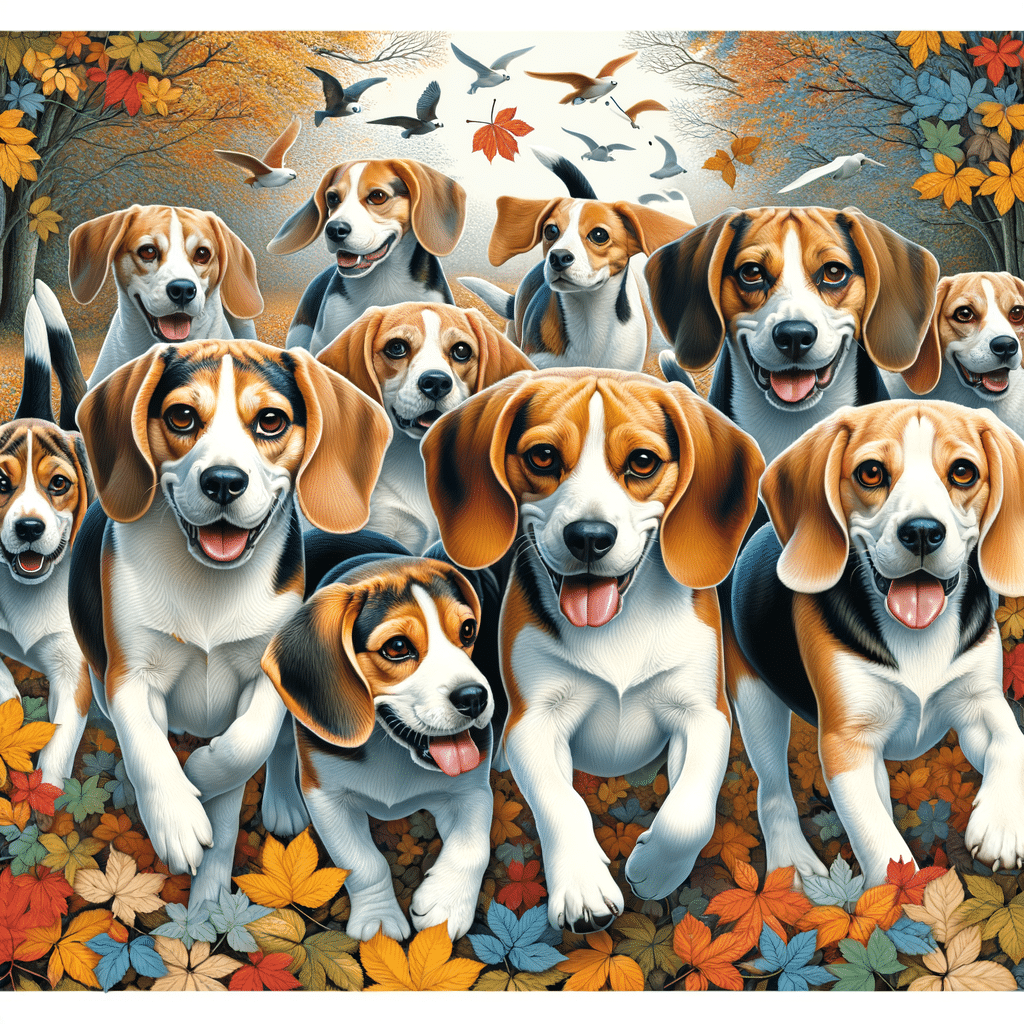The beagle-blue heeler mix is a crossbreed combining two popular dog breeds, the beagle, known for its keen sense of smell and tracking instincts, and the Australian Cattle Dog, also known as the blue heeler, loved for its herding skills and sharp intelligence. This hybrid breed inherits qualities from both parents, resulting in an intelligent and active dog with a strong desire to be involved in family activities, a potential for independence, and self-directed behavior.
In This Article
In terms of appearance, these mixes can vary widely, even amongst littermates, due to the distinctive physical traits of the two parent breeds. The blue heeler’s solid build and the beagle’s compact size may combine in various ways, presenting owners with a unique pet each time. These dogs typically require a good amount of exercise and mental exercise to stay healthy and content, and their education should start early to harness their natural inclinations for learning and activity.
Highlights
- The beagle blue heeler mix is a smart, energetic mix of a beagle and an Australian Cattle Dog.
- Appearance can vary significantly within the same litter due to differences in the parent breeds.
- Proper care, training, and early socialization are crucial for this mix to thrive.
Breed Overview
The beagle-blue heeler mix is known for its intelligence, energy, and the affectionate nature it inherits from its ancestors.
Origin and History
The beagle blue heeler mix, sometimes called the “beagle heeler,” is a relatively recent crossbreed. The parent breed, the beagle, is a scent hound with origins dating back to England, used primarily for hunting small game. The blue heeler, or Australian Cattle Dog, has a history of herding cattle in Australia and is noted for its high energy and resilience.
Physical Characteristics
In terms of size, this mixed breed usually falls into the medium category, inheriting physical traits from both its beagle and blue heeler parents. Coat can range in color, exhibiting shades of blue, black, and brown, and patterns specific to the blue heeler can be prominent. Their appearance varies significantly, with some dogs bearing more resemblance to the beagle and others to the blue heeler.
Personality and Temperament
This mix breed is often described as intelligent and loyal, consistently showing a friendly and affectionate demeanor. They exhibit high energy levels, making them very active and curious. However, potential owners should be aware of their stubbornness, which does not overshadow their capacity to be incredible, loving family members with the proper training.
Health and Lifespan
Common health issues affecting both beagles and blue heelers, such as hip dysplasia, progressive retinal atrophy, epilepsy, deafness, hypothyroidism, and ear infections, can sometimes be inherited by this mix. With proper care and regular veterinary checkpoints, the beagle-blue heeler mix can be expected to live for up to 15 years.
Care and Management
Proper care and management of a beagle and blue heeler mix hinge on understanding their high energy levels, intelligence, and need for mental and physical stimulation. This hybrid thrives on a balanced diet, consistent training, and regular exercise.
Training and Mental Stimulation
The beagle-blue heeler mix is an intelligent breed that can learn quickly. They respond to positive reinforcement and require consistent, patient training to curb their sometimes stubborn behavior. Incorporate training sessions that offer mental stimulation to prevent boredom. Puzzle toys and scent games can cater to their inquisitive nature.
Diet and Nutrition
A well-balanced diet is crucial for this mixed breed to maintain health and energy. They should be fed high-quality dog food that’s rich in animal protein. Monitoring their food intake helps to prevent obesity; they can be prone to obesity if not exercised sufficiently. Consult a vet to establish a suitable feeding plan tailored to the dog’s age, weight, and activity level.
Exercise Requirements
The beagle-blue heeler mix inherits the high energy levels of both parent breeds and hence needs plenty of exercise. Daily activities should include long walks, runs, or agility training to satisfy their exercise requirements. This breed revels in tasks that challenge them physically and mentally, so include herding activities or interactive play sessions to keep them engaged.
Grooming and Shedding
While the grooming needs aren’t extensive, this mixed breed does shed. Regular brushing a few times per week helps manage shedding and keeps their fur in good condition. Bathing should be done as necessary, and it’s important to clean their ears to reduce infections, a common issue with beagles due to their floppy ears.
Adoption and Breeding
Adopting or breeding a beagle blue heeler mix requires careful consideration and understanding of the breed’s traits. This guide will assist in making informed decisions during the adoption or breeding process.
Finding a Reputable Breeder
When searching for a beagle-blue heeler mix, it’s crucial to find knowledgeable breeders who prioritize their puppies’ well-being. Reputable breeders provide health clearances for both parent breeds and allow potential owners to visit and observe the puppies’ living conditions. Dog owners should conduct thorough research to ensure they work with someone transparent about the breed’s traits and health.
Considerations for Families and Other Pets
The beagle-blue heeler mix is known for being a loyal companion and a good family dog. They generally thrive in an environment with solid socialization practices and can live with children and other pets if introduced properly. However, due to their blue heeler lineage, they may have instincts to herd and could nip at children or animals without proper training.
Living Environment and Adaptability
This hybrid is active and adaptable, making it suitable for various living environments. They possess the working dog vigor from the blue heeler side and the trainable nature of beagles. An ideal setting would provide ample exercise and mental stimulation space to accommodate their high energy levels.
Breed Popularity and Availability
Beagle-blue heeler mixes may not be as commonly found as other designer dogs, but they are gaining popularity. Prospective adopters may need to join waiting lists or contact specialized breeders. Adoption fees can vary depending on the breeder’s location, the puppies’ health and the parent breeds’ pedigree. While price is a factor, the emphasis should always be on supporting ethical breeding practices.
Frequently Asked Questions
When considering a beagle and blue heeler mix, prospective dog owners often have several questions about the breed’s characteristics. Addressing these frequently asked questions clarifies what to expect from these hybrid dogs.
What are the common characteristics of beagle and blue heeler mix puppies?
Beagle and blue heeler mix puppies typically display a blending of traits from the parent breeds. They are known to be intelligent, energetic, and curious, with a strong desire to be involved in activities.
What is the average size and weight of a beagle-blue heeler dog when fully grown?
A fully grown beagle mixed with a blue heeler usually measures between 14-18 inches at the withers and can weigh between 18-28 pounds, depending on the specific traits inherited from the parents.
How does the temperament of a beagle-blue heeler mix typically compare to its parent breeds?
The temperament of a beagle and blue heeler mix often combines the beagle’s happy-go-lucky nature with the blue heeler’s intelligence and dedication. These dogs may also exhibit the beagle’s sociability and the blue heeler’s work ethic.
What factors influence the price of a blue heeler and beagle mixed puppy?
The price of a blue heeler and beagle mix puppy can be influenced by factors such as breeder reputation, geographic location, bloodline of the parents, and the presence of any unique traits or markings.
Can you provide information on the life expectancy of beagle-blue heeler mix dogs?
Beagle and blue heeler mix dogs can expect to live 12 to 15 years, depending on health factors, genetics, and the quality of care they receive throughout their lives.






